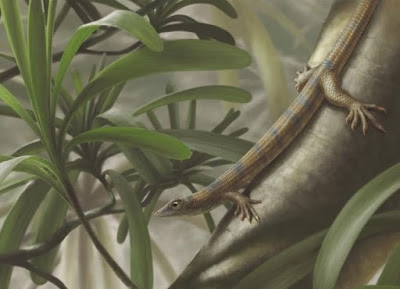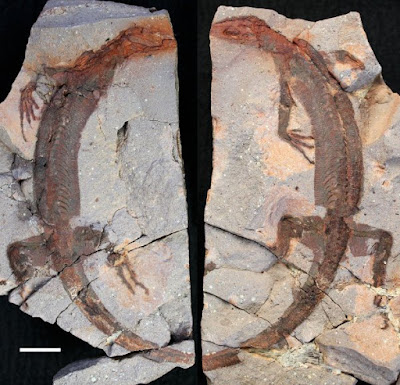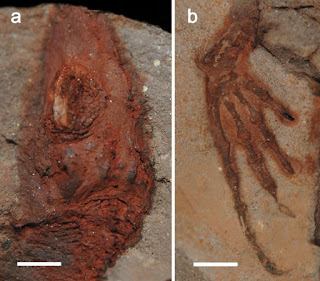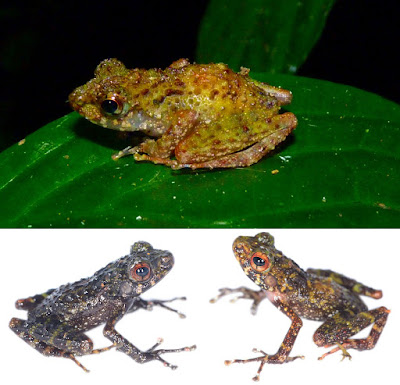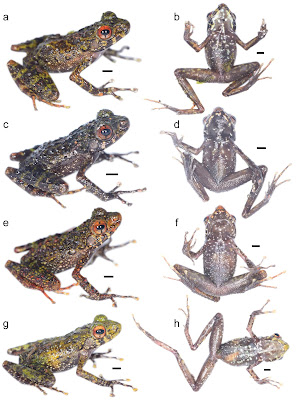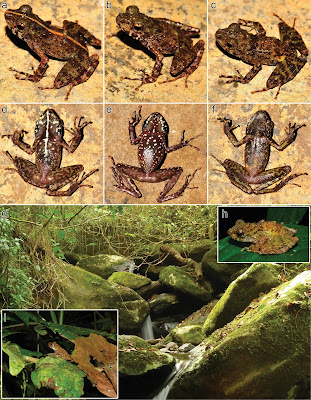![]() |
Bohuslania matsmichaeli
Korshunova, Lundin, Malmberg, Picton & Martynov, 2018
|
Abstract
A unique example of brackish water fjord-related diversification of a new nudibranch genus and species Bohuslania matsmichaeli gen. n., sp. n. is presented. There are only few previously known brackish-water opisthobranchs and B. matsmichaeli gen. n., sp. n. is the first ever described brackish-water nudibranch with such an extremely limited known geographical range and apparently strict adherence to salinity levels lower than 20 per mille. Up to date the new taxon has been found only in a very restricted area in the Idefjord, bordering Sweden and Norway, but not in any other apparently suitable localities along the Swedish and Norwegian coasts. We also show in this study for the first time the molecular phylogenetic sister relationship between the newly discovered genus Bohuslania and the genus Cuthona. This supports the validity of the family Cuthonidae, which was re-established recently. Furthermore, it contributes to the understanding of the evolutionary patterns and classification of the whole group Nudibranchia. Molecular and morphological data indicate that brackish water speciation was triggered by paedomorphic evolution among aeolidacean nudibranchs at least two times independently. Thus, the present discovery of this new nudibranch genus contributes to several biological fields, including integration of molecular and morphological data as well as phylogenetic and biogeographical patterns.
![]()
![]()
![]() |
Fig 2. Morphology of Bohuslania matsmichaeli gen. n., sp. n.
A, Dorsal appearance of the holotype; B. Ventral appearance holotype; C. Living specimen and its egg mass in situ; D, Pharynx and jaws (Paratype GNM 9024); E, Masticatory processes of jaws with denticles |
![]() |
Fig 2. Morphology of Bohuslania matsmichaeli gen. n., sp. n. F, Radula, central teeth (Holotype); G, Reproductive system of the holotype (non-destructive SEM with “nano-coating”); H, copulative organ (same technique as in G); I, Scheme of reproductive system.
Scales: 10 μm (F, G, H), 500 μm (I).
Abbreviations: a–ampulla, fgm–female gland mass, fgo–female opening, hd–hermaphroditic duct, p–penis, pg–penial gland, pr–prostate, ps–penial sheath, rsp–proximal receptaculum seminis, vd–vas deferens, v–vagina. |
![]() |
Fig 2. Morphology of Bohuslania matsmichaeli gen. n., sp. n. A, Dorsal appearance of the holotype; B. Ventral appearance holotype; C. Living specimen and its egg mass in situ; D, Pharynx and jaws (Paratype GNM 9024); E, Masticatory processes of jaws with denticles;
F, Radula, central teeth (Holotype); G, Reproductive system of the holotype (non-destructive SEM with “nano-coating”); H, copulative organ (same technique as in G); I, Scheme of reproductive system.
Scales: 10 μm (F, G, H), 500 μm (I). Abbreviations: a–ampulla, fgm–female gland mass, fgo–female opening, hd–hermaphroditic duct, p–penis, pg–penial gland, pr–prostate, ps–penial sheath, rsp–proximal receptaculum seminis, vd–vas deferens, v–vagina. |
![]() |
| Fig 1. Phylogenetic tree of aeolidacean nudibranchs based on concatenated molecular data (COI + 16S + 28S + H3) represented by Bayesian Inference (BI). The aeolidacean families are highlighted. The brackish-water living, but non-related taxa Bohuslania gen. n. and Tenellia are indicated as “BW”. Numbers above branches represent posterior probabilities from Bayesian Inference. Numbers below branches indicate bootstrap values for Maximum Likelihood. |
![]() |
| Fig 4. Ontogenetic and phylogenetic framework for evidence of parallel paedomorphosis driven-evolution within the brackish-water nudibranchs of the families Cuthonidae (Bohuslania gen. n.) and Trinchesiidae (Tenellia adspersa). Adults (14 and 20 mm) of marine species Cuthona nana and C. divae respectively, considerably differ from adults of brackish-water Bohuslania matsmichaeli gen. n., sp. n., whereas juveniles of C. nana (6 mm length) and C. divae (5 mm length) are similar to the adult of B. matsmichaeli (10 mm length) by presence of only 3–4 anterior ceratal rows and absence of numerous pre-rhinophoral digestive gland branches. Because Bohuslania, compared to Cuthona, does not develop further to reach the stage with numerous anterior ceratal rows, this stage is considered missing in Bohuslania (indicated by “X” on the scheme) due to heterochronic developmental shifts leading to the adult paedomorphic external morphology. The brackish-water species Tenelliaadspersa (adult, 6 mm length) demonstrates a striking paedomorphic feature in presence of secondary oral veil. However, it belongs to the family Trinchesiidae which is more distantly related to the family Cuthonidae according to the present molecular phylogenetic analysis (Figs 1 and 2). Since the appearance of the small oral veil occurs in earlier ontogeny of aeolidacean nudibranchs and predates formation of oral tentacles and numerous anterior ceratal rows, the two stages of development of external features are considered as missing in Tenellia adspersa (indicated by two “X” on the scheme). |
....
The molecular phylogenetic results confirm the morphological analysis data. From the only other genus of the family Cuthonidae, Cuthona Alder & Hancock, 1855, Bohuslania gen. n. is morphologically readily distinguished by absence of the pre-rhinophoral rows of cerata and considerably smaller number of rows of the anterior digestive gland.
Taxonomy
Class Gastropoda
Order Nudibranchia
Family Cuthonidae Odhner, 1934
Diagnosis: Body wide. Notal edges fully reduced. Cerata non-elevated, numerous per row. Ceratal rows branched. Anus acleioproctic or cleioproctic. Radula formula 0.1.0. Central teeth with strong cusp not compressed by adjacent lateral denticles. Vas deferens short, with weak prostate. Supplementary gland present, inserts to unarmed copulative organ.
Included genera: Cuthona Alder & Hancock, 1855, Bohuslania gen. n.
Genus Bohuslania gen. n.
Type species: Bohuslania matsmichaeli gen. n., sp. n.
Diagnosis: Three to four anterior rows of cerata, pre-rhinophoral cerata absent, head broad, oral tentacles placed towards lateral edges of head, no anterior foot corners, anus acleioproctic, jaws with single row of simple denticles, radular teeth narrow with prominent cusp, penis without stylet.
Etymology: After Bohuslän region in southern Sweden, where the only locality of this new genus and species in the Idefjord is known.
Species included: B. matsmichaeli sp. n.
Bohuslania matsmichaeli sp. n.
Holotype: Sweden, Idefjord, 59° 02.400' N 11° 24.430'E, inner part of the Idefjord, off beach east of Boråsgården, 7 m depth, 2013-10-8, coll. Mats Larsson and Michael Lundin (ZMMU Op-600, 3 mm in length preserved, 10 mm living length).
Type locality: Idefjord, Bohuslän region.
Etymology: This species is named in honour of Mats Larsson and Michael Lundin, who were the first to discover this unique taxon.
Description: The length of the preserved holotype is 3 mm (living is 10 mm). The preserved length of 9 mature paratype specimens ranged from 3 to 4 mm. The body is moderately broad (Fig 2A and 2B). The rhinophores are slightly longer than oral tentacles, smooth. The cerata are relatively long, thin and finger-shaped. Pre-rhinophoral cerata absent. Ceratal formula of the holotype: right (4,5,5; Anus,4,3,3,2,2) left (3,4,5; 4,3,2,2). Paratype specimens possess 3–4 pre-anal branches of anterior digestive gland. The head is broad, semicircular, oral tentacles placed towards edges of the head. The foot is moderate, anteriorly rounded, no foot corners.
Biology: Inhabits mixed environment with stones and mud in shallow (5–7 m) brackish water (15–18 per mille). The athecate hydroid Cordylophora caspia was found in the area and can be a probable food source for B. matsmichaeli. Potentially two techate hydroids could possibly also inhabit the area, Gonothyraea loveni and Laomedea flexuosa but these were not found together with B. matsmichaeli. The egg mass is in the shape of a narrow whitish spiral cord with about 3 whorls (Fig 2C). The egg mass contains about 250 eggs.
Distribution: To date known only from the internal parts of the Idefjord in the Bohuslän region.
Tatiana Korshunova, Kennet Lundin, Klas Malmberg, Bernard Picton and Alexander Martynov. 2018. First True Brackish-water Nudibranch Mollusc provides New Insights for Phylogeny and Biogeography and Reveals Paedomorphosis-driven Evolution.
PLoS ONE. 13(3): e0192177. DOI:
10.1371/journal.pone.0192177





